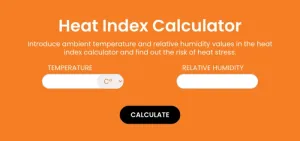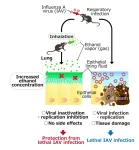In the summer of 2022, over 20,000 excess deaths across Spain, France, Germany and Great Britain were suggested to have been linked to extremely hot weather. In the context of global warming where climate models point to the fact that extreme heat waves are likely to increase both in frequency and magnitude, preventive measures and adequate communication of dangerous conditions take on special relevance. In a Brief Communication published in npj Climate and Atmospheric Science, researchers from the Barcelona Institute for Global Health (ISGlobal), a centre supported by the ”la Caixa” Foundation, and the London School of Hygiene and Tropical Medicine (LSHTM) warn that relying solely on expected temperatures in communication of dangerous heatwave conditions can be insufficient to inform people about the true health risks. The team calls for the widespread use of so-called heat stress indices, which besides temperature take into account other meteorological factors such as humidity, to better communicate the impacts of extreme heat stress conditions.
“It is the wider set of meteorological conditions that can affect one’s response to outdoor heat – starting from the ambient temperature, as well as humidity of the surrounding air, the prevailing wind conditions, exposure to the direct sun versus being in shade, and finally the total duration of exposure to such conditions”, says Malcolm Mistry, from the London School of Hygiene and Tropical Medicine (LSHTM) and Ca’ Foscari University of Venice, and a co-author of the study. “Communicating expected maximum temperatures only,” he continues, “may not always reflect the true danger of ongoing heatwaves. For example, the same ambient temperature of 35°C can be uncomfortable at low humidity but dangerous to human health at high humidity, even for a short period of time.”
Although each person's threshold of resistance to heat varies according to a number of individual factors, different heat stress indices have been designed to describe the impact of meteorological conditions on the human body, including the point at which the conditions experienced can become a threat to human health. Some of the better-known examples are, humidex (Hu), apparent temperature (AT), wet bulb globe temperature (WBGT), heat index (HI) and universal thermal climate index (UTCI). This is particularly relevant in view of the so-called "humid heat waves", which are expected to become more frequent as a consequence of climate change.
Different Perception of “Danger Zones”
The team looked into recent record-breaking heatwaves in Europe, North America and Asia and compared the maps of maximum daily temperatures with the maximum daily heat stress indices (humidex and indoor wet bulb globe temperature). The geographical areas where the heat indices revealed the highest risk of heat stress did not necessarily coincide with the regions where the highest temperatures were recorded.
For example, during the heatwaves in Europe in June and July 2019, records show that central and north-eastern Spain experienced the highest temperatures. However, calculating the heat stress indices, the researchers found that the areas with the most critical conditions were in France, Belgium and the Netherlands, countries that reported an excess mortality of 2,500 deaths. Another of the cases mentioned was the episode of extreme heat that occurred in western parts of Canada and the northwest United States in June 2021. While the maximum temperatures were recorded in the states of Washington and Oregon, heat stress indices revealed that Canadian provinces such as Alberta, the Northwest Territories and British Columbia also experienced dangerous conditions, with the latter recording 600 heat-related deaths.
Encouragingly, heat indices are being increasingly implemented in weather forecasts by the meteoservices around the world. Some examples include humidex in Canada, UTCI in Germany and Heat Index in USA. “What is still missing is having heat indices communicated to the population in a regular manner as it is traditionally done using temperatures”, states lead author Ivana Cvijanovic. “This could be helped by the scientific community reaching a consensus on which heat index is best to communicate and which danger levels to use.”
Another heat wave the team looked at was the major heat wave that hit India and Pakistan in May 2022, when temperatures over 50°C were recorded. Once again, the heat indices revealed danger zones that were not limited to those with the highest temperatures. "Episodes of extreme heat that push humans to the edge of survival, like the one recorded in India and Pakistan in May 2022, are likely to become more frequent as climate models highlight, and we need to do everything we can to be as well prepared as possible to deal with them," says Xavier Rodó, head of ISGlobal's Climate and Health programme and one of the authors of the study, “Unfortunately, health data from this heatwave was not available and would certainly be useful to the scientific and medical communities to both better understand the nature and extent of the effects of such mega heat waves, and to educate us on how to prepare for such outcomes”.
“Lessons learned from the recent major heatwaves suggest that improved protocols for action during heatwaves are needed. Once the meteorological warning has been issued there is need for a clear chain of responsibilities. The authorities need to act promptly and know when to close schools or stop outdoor sports activities, open cooling centers for socially vulnerable populations and ensure the sufficient emergency response.”, says Ivana Cvijanovic.
“Educating the general population on how to behave during heat waves is very important too. Knowing how to recognize the signs of heat related illness (and what to do in case of) and creating a “no one left behind” culture with people checking on their elderly neighbours or anyone seemingly vulnerable can help save lives. We also need to have solutions in place in case of power outages - when we cannot rely on cooling mechanisms such as air-conditioning. Finally, we must not forget animals and pets, as they will need protection during these times too”, concludes Cvijanovic.
ISGlobal Presents a Heat Index Calculator
In parallell to the communication paper published in npj Climate and Atmospheric Science, a team from ISGlobal has created a heat index calculator. The easy-to-use tool calculates the heat index and provides a guidance on the level of risk together with the recommendations on how to stay safe when the conditions are hazardous. To operate the calculator, users just need to introduce temperature and relative humidity values, both of which are provided by many of the domestic thermometer models in the market, and that way they can obtain an estimation of the conditions in any of the rooms of their homes.
Although there are other heat index calculators available online, this is the first one to use the extended and corrected Heat Index that was recently developed by the UC Berkeley researchers. The tool is intended to provide estimates of indoor risk and is openly available at www.isglobal.org/heat-index-calculator.
"In the same way that we consult forecasts on a daily basis —and especially whenever there is an extreme weather event coming—, we need to get used to incorporating tools like this heat index calculator to learn to live with sustained hazardous levels of heat like we never had before. A fundamental part of this is to communicate better and raise awareness of the importance of factors such as relative humidity in gauging risk", says Pau Rubio, Communication Coordinator at ISGlobal and a member of the team that developed the calculator.
For more information, visit ISGlobal’s Heat Index Calculator.
Reference
Ivana Cvijanovic, Malcolm N. Mistry, James D. Begg, Antonio Gasparrini, Xavier Rodó. Importance of humidity for characterization and communication of dangerous heatwave conditions. npj Climate and Atmospheric Science, 2023. doi:10.1038/s41612-023-00346-x
END




